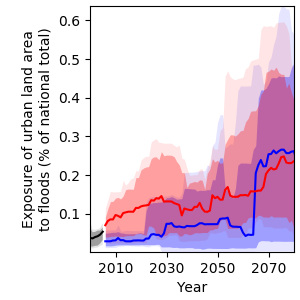Côte d’Ivoire: Infrastructure
Climate change is expected to significantly affect Côte d’Ivoire’s infrastructure sector through extreme weather events. High precipitation amounts can lead to flooding of roads and railroads, especially in low-lying coastal areas, while high temperatures can cause roads, bridges and protective structures to develop cracks and degrade more quickly. Transport infrastructure is vulnerable to extreme weather events, yet essential for agricultural livelihoods. Roads serve communities to trade goods and access healthcare, education, credit and other services, especially in rural and remote areas. Côte d’Ivoire’s transport is dominated by road transport, handling almost all of its internal freight traffic [27]. Furthermore, it is closely linked with landlocked Burkina Faso through the Abidjan-Ouagadougou corridor, an important route for both road and rail transport [28]. The reliance on only few transport routes increases the sector’s vulnerability to climate impacts. Hence, investments will have to be made into building climate-resilient transportation networks.
Extreme weather events will also have devastating effects on human settlements and economic production sites, especially in urban areas with high population densities such as Abidjan or Bouaké. Informal settlements are particularly vulnerable to extreme weather events: Makeshift homes are often built in unstable geographical locations including riverbanks and coastal areas, where flooding can lead to loss of housing, contamination of water, injury or death. Dwellers usually have low adaptive capacity to respond to such events due to high levels of poverty and lack of risk-reducing infrastructures. For example, heavy rains in October 2019 have caused flooding in Abidjan, Aboisso, Grand Bassam, Ayamé and Man. A total of 12 900 people were affected by this flooding including 12 fatalities [29]. Flooding and droughts will also affect hydropower generation: Côte d’Ivoire draws 40 % of its energy from hydropower and has been investing in large-scale hydropower projects including the Soubré Dam, which was inaugurated in 2017 and is the country’s largest dam with a capacity of 275 MW [30], [31]. However, variability in precipitation and climatic conditions could severely disrupt hydropower generation.
Despite the risk of infrastructure damage being likely to increase due to climate change, precise predictions of the specific location and extent of exposure are difficult to make. For example, projections of river flood events are subject to substantial modelling uncertainty, largely due to the uncertainty of future projections of precipitation amounts and their spatial distribution, affecting flood occurrence (see also Figure 5). In the case of Côte d’Ivoire, projections show a slight increase in the exposure of major roads to river floods under both RCPs: In 2000, 0.5 % of major roads were exposed to river floods at least once a year, while by 2080, this value is projected to increase to 0.6 % under RCP2.6 and to 1.3 % under RCP 6.0 (Figure 13). In a similar way, exposure of urban land area to river floods is projected to increase only slightly, from 0.04 % in 2000 to 0.2 % in 2080 under both RCPs (Figure 14). However, projections of exposure of major roads and urban land area to river floods are characterised by high modelling uncertainty, which is why no reliable estimations on future occurrence of river floods can be made.


With the exposure of the GDP to heatwaves projected to increase from around 7 % in 2000 to 31 % (RCP2.6) and 27 % (RCP6.0) by 2080 (Figure 15), it is recommended that economic policy planners start identifying heat-sensitive production sites and activities, and integrating climate adaptation strategies such as improved solar-powered cooling systems, “cool roof” isolation materials or switching operation hours from day to night [32].

References
[27] Oxford Business Group, “Côte d’Ivoire Revamps Infrastructure in Transport Sector to Support Economic Growth.” Online available: https://oxfordbusinessgroup.com/overview/adding-capacity-revampingsector-infrastructure-support-economic-growth [Accessed: 17-Feb-2020].
[28] V. Foster and N. Pushak, “Côte d’Ivoire’s Infrastructure: A Continental Perspective,” Washington, D.C., 2011. [29] International Federation of Red Cross and Red Crescent Societies, “Emergency Plan of Action (EPoA) Côte d’Ivoire: Floods,” Geneva, Switzerland, 2019.
[30] USAID, “Power Africa: Côte d’Ivoire,” Washington, D.C., 2019.
[31] Reuters, “Ivory Coast to Bring 275 MW Hydropower Plant Online Next Month,” 2017. Online available: https://www.reuters.com/article/ivorycoast-electricity/ivory-coast-to-bring-275-mw-hydropower-plantonline-next-month-idUSL5N1GJ4Z8 [Accessed: 17-Feb-2020].
[32] M. Dabaieh, O. Wanas, M. A. Hegazy, and E. Johansson, “Reducing Cooling Demands in a Hot Dry Climate: A Simulation Study for Non-Insulated Passive Cool Roof Thermal Performance in Residential Buildings,” Energy Build., vol. 89, pp. 142–152, 2015.


